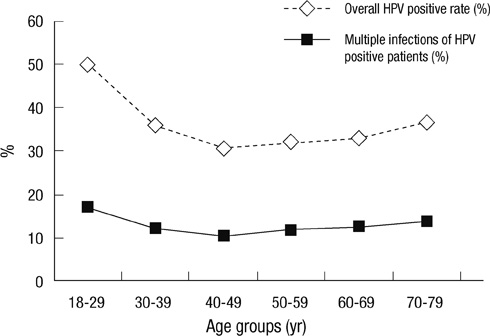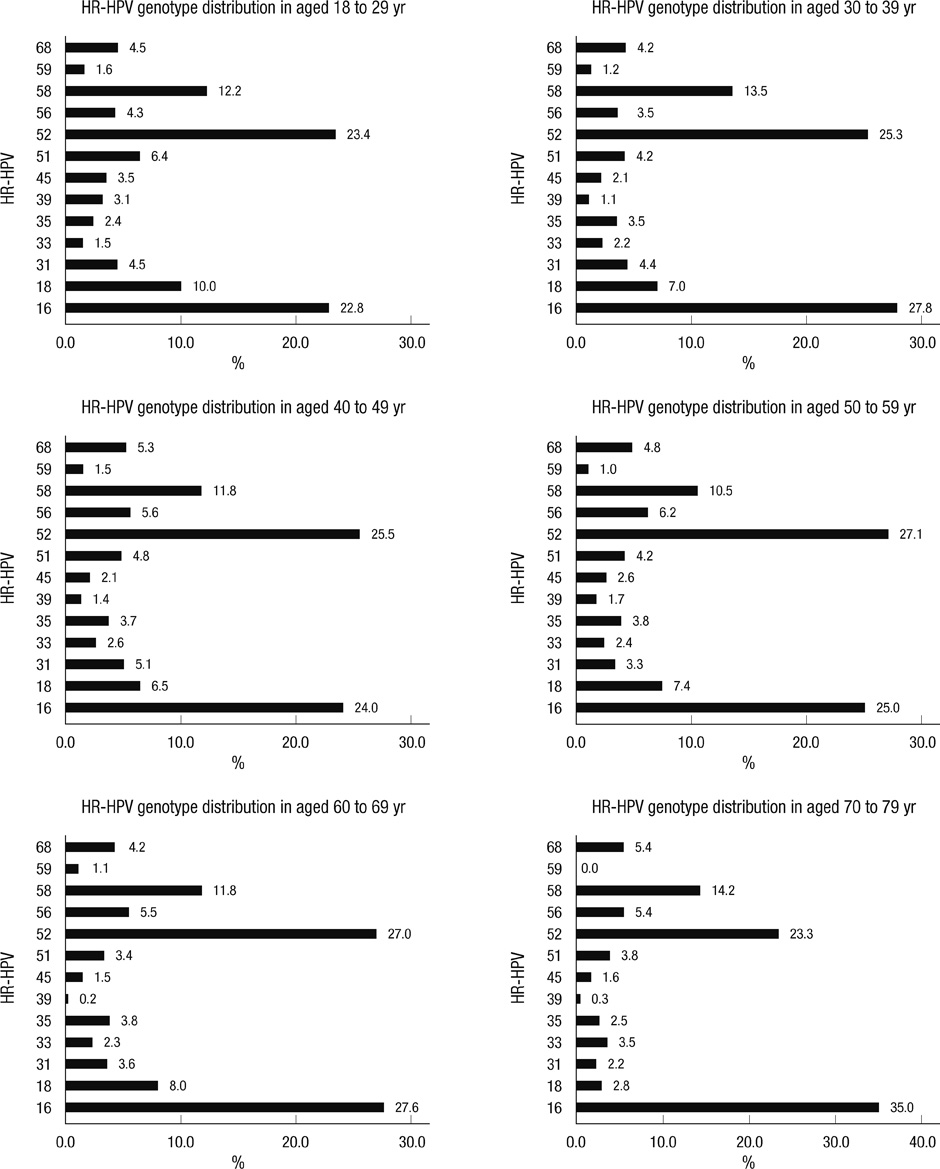Prevalence and Distribution of Human Papillomavirus Infection in Korean Women as Determined by Restriction Fragment Mass Polymorphism Assay
- Affiliations
-
- 1Department of Laboratory Medicine, Green Cross Reference Laboratory, Yongin, Korea.
- 2Department of Laboratory Medicine, College of Medicine, Inje University, Goyang, Korea.
- 3Department of Laboratory Medicine, Asan Medical Center, College of Medicine, University of Ulsan, Seoul, Korea.
- 4Department of Laboratory Medicine, Korea Cancer Center Hospital, Korea Institute of Radiological and Medical Sciences, Seoul, Korea.
- 5Department of Laboratory Medicine, College of Medicine, Chung-Ang University, Seoul, Korea. chayoung@cau.ac.kr
- KMID: 1782145
- DOI: http://doi.org/10.3346/jkms.2012.27.9.1091
Abstract
- The development of a prophylactic vaccine that targets human papillomaviruses (HPV) 6, 11, 16, and 18 to prevent cervical cancer has increased interest in the ethnic and geographical distributions of HPV genotypes. We investigated HPV prevalence and type distribution by restriction fragment mass polymorphism (RFMP) testing a total of 60,775 specimens (aged 18-79 yr, median 44) taken from liquid-based cytology. Overall HPV positive rate of total patients was 34.2%. Among the positive patients, 87.7% was single type infections, and 12.3% was multiple HPV types. HPV-16 was the most prevalent genotype observed in 2,307 (26.0%), followed by type 52 in 2,269 (25.5%), type 58 in 1,090 (12.3%), type 18 in 633 (7.1%), type 56 in 436 (4.9%). The pattern of high risk-HPV positive rate according to age showed U-shape with a peak in HPV prevalence among women less than 30 yr of age, and a second peak among the older females aged 70 to 79 yr. The leading four high-risk HPV genotypes were HPV-16, HPV-52, HPV-58, and HPV-18 in descending order. In conclusion, this study provides the most representative prevalence and type-specific distribution of HPV among Korean women, and demonstrates that the epidemiology of HPV infection is different from that of other regions of the world.
Keyword
MeSH Terms
-
Adolescent
Adult
Age Factors
Aged
Asian Continental Ancestry Group
DNA, Viral/analysis
Female
Genotype
Human papillomavirus 16/genetics
Human papillomavirus 18/genetics
Humans
Middle Aged
Papillomavirus Infections/*epidemiology/virology
*Polymorphism, Restriction Fragment Length
Prevalence
Republic of Korea/epidemiology
Spectrometry, Mass, Matrix-Assisted Laser Desorption-Ionization
Young Adult
DNA, Viral
Figure
Cited by 7 articles
-
Knowledge Level of Human Papillomavirus, Cervical Cancer and Vaccination Status among Mothers with Daughters in High School
Myung-Sook Yoo
Korean J Women Health Nurs. 2014;20(1):105-114. doi: 10.4069/kjwhn.2014.20.1.105.Current Status of Human Papillomavirus Infection and Introduction of Vaccination to the National Immunization Program in Korea: an Overview
Min-A Kim, Gwan Hee Han, Jae-Hoon Kim, Kyung Seo
J Korean Med Sci. 2018;33(52):. doi: 10.3346/jkms.2018.33.e331.Status of HPV vaccination among HPV-infected women aged 20–60 years with abnormal cervical cytology in South Korea: a multicenter, retrospective study
Jaehyun Seong, Sangmi Ryou, Myeongsu Yoo, JeongGyu Lee, Kisoon Kim, Youngmee Jee, Chi Heum Cho, Seok Mo Kim, Sung Ran Hong, Dae Hoon Jeong, Won-Chul Lee, Jong Sup Park, Tae Jin Kim, Mee-Kyung Kee
J Gynecol Oncol. 2020;31(1):. doi: 10.3802/jgo.2020.31.e4.Effects of Human Papilloma Virus on related Education for Female High School Students
Jun-Young Choi, So-Young Choi
Asian Oncol Nurs. 2013;13(3):128-135. doi: 10.5388/aon.2013.13.3.128.Factors Associated with Human Papillomavirus Vaccination and Intention among Male and Female College Students
Seung Yeun Lee, Mi Ah Han, Jong Park, So Yeon Ryu
Korean J Health Promot. 2015;15(3):141-149. doi: 10.15384/kjhp.2015.15.3.141.Recommended Managements for the Male Human Papillomavirus Infection
Jun Hyun Han
Korean J Urogenit Tract Infect Inflamm. 2014;9(2):79-85. doi: 10.14777/kjutii.2014.9.2.79.Predicted Cervical Cancer Prevention: Impact of National HPV Vaccination Program on Young Women in South Korea
Kyeongmin Kwak, Seung-sik Hwang
Cancer Res Treat. 2024;56(3):898-908. doi: 10.4143/crt.2023.981.
Reference
-
1. zur Hausen H. Papillomaviruses and cancer from basic studies to clinical application. Nat Rev Cancer. 2002. 2:342–350.2. de Villiers EM, Whitley C, Gunst K. Identification of new papillomavirus types. Methods Mol Med. 2005. 119:1–13.3. Munoz N, Bosch FX, de Sanjose S, Herrero R, Castellsague X, Shah KV, Snijders PJ, Meijer CJ. International Agency for Research on Cancer Multicenter Cervical Cancer Study Group: epidemiological classification of human papillomavirus types associated with cervical cancer. N Engl J Med. 2003. 348:518–527.4. Huang S, Afonina I, Miller BA, Beckmann AM. Human papillomavirus types 52 and 58 are prevalent in cervical cancers from Chinese women. Int J Cancer. 1997. 70:408–411.5. Lai HC, Sun CA, Yu MH, Chen HJ, Liu HS, Chu TY. Favorable clinical outcome of cervical cancers infected with human papillomavirus type 58 and related types. Int J Cancer. 1999. 84:553–557.6. Clifford GM, Smith JS, Plummer M, Munoz N, Franceschi S. Human papilloma virus types in invasive cervical cancer worldwide: a meta-analysis. Br J Cancer. 2003. 88:63–73.7. Um TH, Lee EH, Chi HS, Kim JW, Hong YJ, Cha YJ. Comparison of HPV genotyping assays and hybrid capture 2 for detection of high-risk HPV in cervical specimens. Ann Clin Lab Sci. 2011. 41:48–55.8. Hong SP, Shin SK, Lee EH, Kim EO, Ji SI, Chung HJ, Park SN, Yoo W, William R, Folk WR, et al. High-resolution human papillomavirus genotyping by MALDI-TOF mass spectrometry. Nat Protoc. 2008. 3:1476–1484.9. Lee JK, Hong YJ, Um TH, Lee EH, Chi HS, Koh JS, Yim HW, Cha YJ. Detection and identification of human papillomavirus using a PCR-restriction fragment mass polymorphism assay. Mol Med Report. 2011. 4:645–650.10. de Sanjosé S, Diaz M, Castellsagué X, Clifford G, Bruni L, Muñoz N, Bosch FX. Worldwide prevalence and genotype distribution of cervical human papillomavirus DNA in women with normal cytology: a meta-analysis. Lancet Infect Dis. 2007. 7:453–459.11. Ostor AG. Natural history of cervical intraepithelial neoplasia: a critical review. Int J Gynecol Pathol. 1993. 12:186–192.12. Clifford GM, Gallus S, Herrero R, Munoz N, Snijders PJ, Vaccarella S, Anh PT, Ferreccio C, Hieu NT, Matos E, et al. Worldwide distribution of human papillomavirus types in cytologically normal women in the international Agency for Research on Cancer HPV prevalence surveys: a pooled analysis. Lancet. 2005. 366:991–998.13. Poljak M, Marin IJ, Seme K, Vince A. Hybrid capture II HPV test detects at least 15 human papillomavirus genotypes not included in its current high-risk probe cocktail. J Clin Virol. 2002. 25:S89–S97.14. Huang SL, Chao A, Hsueh S, Chao FY, Huang CC, Yang JE, Lin CY, Yan CC, Chou HH, Huang KG, et al. Comparison between the Hybrid Capture II Test and an SPF1/GP6þ PCR-based assay for detection of human papillomavirus DNA in cervical swab samples. J Clin Microbiol. 2006. 44:1733–1739.15. Lee SA, Kang D, Seo SS, Jeong JK, Yoo KY, Jeon YT, Kim JW, Park NH, Kang SB, Lee HP, et al. Multiple HPV infection in cervical cancer screened by HPV DNA Chip. Cancer Lett. 2003. 198:187–192.16. Lee YH, Choe JY, Park SH, Park YW, Lee SS, Kang YM, Nam EJ, Park W, Kwon SR, Bae SC, et al. Prevalence of human papillomavirus infections and cervical cytological abnormalities among Korean women with systemic lupus erythematosus. J Korean Med Sci. 2010. 25:1431–1437.17. Cho NH, An HJ, Kim JJ, Kang S, Kim JW. Genotyping of 22 human papillomavirus types by DNA chip in Korean women: comparison with cytologic diagnosis. Am J Obstet Gynecol. 2003. 188:56–62.18. Oh YL, Shin KJ, Han J, Kim DS. Significance of high-risk human papillomavirus detection by polymerase chain reaction in primary cervical cancer screening. Cytopathology. 2001. 12:75–83.19. Hwang HS, Park M, Lee SY. Distribution and prevalence of human papillomavirus genotypes in routine pap smear of 2,470 Korean women determined by DNA chip. Cancer Epidemiol Biomarkers Prev. 2004. 13:2153–2156.20. Shin HR, Lee DH, Herrero R, Smith JS, Vaccarella S, Hong SH, Jung KY, Kim HH, Park UD, Cha HS, et al. Prevalence of human papillomavirus infection in women in Busan, South Korea. Int J Cancer. 2003. 103:413–421.21. Gravitt PE. The known unknowns of HPV natural history. J Clin Invest. 2011. 121:4593–4599.22. Velicer C, Zhu X, Vuocolo S, Liaw KL, Saah A. Prevalence and incidence of HPV genital infection in women. Sex Transm Dis. 2009. 36:696–703.23. González P, HildesheimA , Rodríguez AC, Schiffman M, Porras C, Wacholder S, Piñeres AG, Pinto AA, Burk RD, Herrero R. Behavioral/lifestyle and immunologic factors associated with HPV infection among women older than 45 years. Cancer Epidemiol Biomarkers Prev. 2010. 19:3044–3054.24. Fife KH, Cramer HM, Schroeder JM, Brown DR. Detection of multiple human papillomavirus types in the lower genital tract correlates with cervical dysplasia. J Med Virol. 2001. 64:550–559.25. Bello BD, Spinillo A, Alberizzi P, Cesari S, Gardella B, D'Ambrosio G, Roccio M, Silini EM. Cervical infections by multiple human papillomavirus (HPV) genotypes: prevalence and impact on the risk of precancerous epithelial lesions. J Med Virol. 2009. 81:703–712.26. Forslund O, Antonsson A, Edlund K, van den, Hansson BG, Meijer CJ, Ryd W, Rylander E, Strand A, Wadell G, et al. Population-based type-specific prevalence of high-risk human papillomavirus infection in middle-aged Swedish women. J Med Virol. 2002. 66:535–541.27. Bosch FX, Manos MM, Munoz N, Sherman M, Jansen AM, Peto J, Schiffman MH, Moreno V, Kurman R, Shah KV. International Biological Study on Cervical Cancer (IBSCC) Study Group. Prevalence of human papillomavirus in cervical cancer: a worldwide perspective. J Natl Cancer Inst. 1995. 87:796–802.28. Walboomers JM, Jacobs MV, Manos MM, Bosch FX, Kummer JA, Shah KV, Snijders PJ, Peto J, Meijer CJ, Munoz N. Human papillomavirus is a necessary cause of invasive cervical cancer worldwide. J Pathol. 1999. 189:12–19.29. Cai HB, Ding XH, Chen CC. Prevalence of single and multiple human papillomavirus types in cervical cancer and precursor lesions in Hubei, China. Oncology. 2009. 76:157–161.30. Barzon L, Giorgi C, Buonaguro FM, Palù G. Guidelines of the Italian Society for Virology on HPV testing and vaccination for cervical cancer prevention. Infect Agent Cancer. 2008. 3:14.
- Full Text Links
- Actions
-
Cited
- CITED
-
- Close
- Share
- Similar articles
-
- Detection and typing of human papillomavirus DNA by PCR using consensus primers in various cervical lesions of Korean women
- Restriction fragment length polymorphism analysis of varicella-zoster virus isolated in Korea
- The Genetic Polymorphism of Alpha 2-Heremans Schmidt Glycoprotein (AHSG), and Antibody to AHSG in Patients with Endometriosis
- A Case of Mycobacterium Marinum Tenosynovitis Diagnosed by the PCR-restriction Fragment Length Polymorphism of the rpoB Gene
- Development of PCR Technology for Identification of the Restriction Fragment Length Polymorphism(RFLP) of the Immunoglobulin Allotypes in Periodontal Patients



